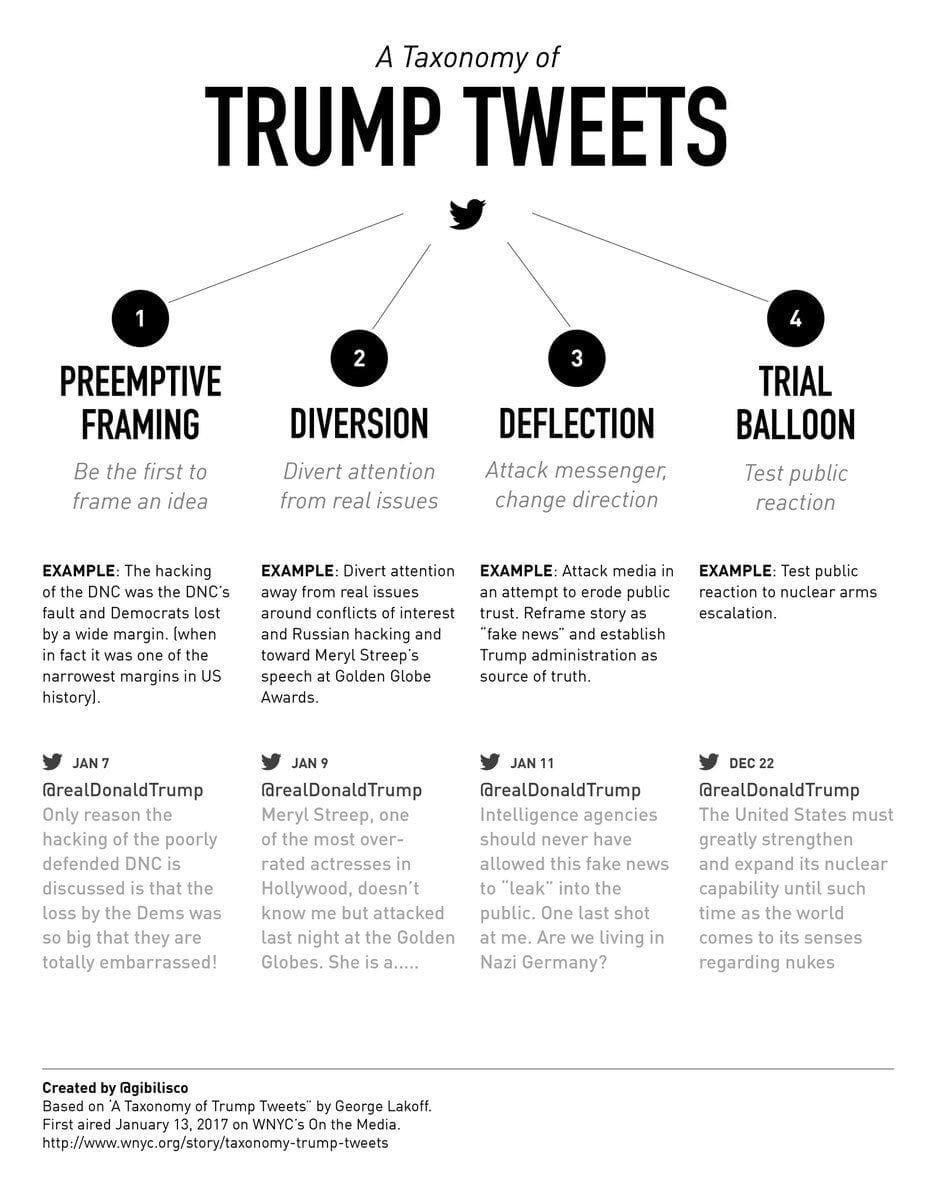Elon Musk's billionaire extremist party exposes ‘centrist’ scam
This is a guest post from FrameLab contributor Jason Sattler. Jason is LOLGOP on BlueSky and pretty much any other
Like Trump, Musk has weaponized tweets for the information war

Note: We wrote this in December 2022, shortly after Elon Musk took control of Twitter – at a time when many other commentators were in denial about what Musk planned to do with the site.
Like Donald Trump before him, Elon Musk uses Twitter to troll our brains and keep our attention focused on his antics.
This is anything but harmless digital horseplay. Musk has a definite strategy. As we wrote in a previous post, Musk is on a mission to shift the political discourse towards radical conservatism in all its toxicity.
Back in 2017, we charted four distinct ways that Trump used Twitter to control the news cycle (and thus control our brains). You may remember the following chart, which went viral and helped define how the disgraced former president was manipulating the public discourse through social media:

Musk uses each of the tactics that Trump did. But as Twitter’s owner, CEO and “chief twit,” he has an extra advantage that will make him an especially dangerous threat to democracy if we’re not careful.
Musk now has vast control over what we hear and see on this powerful media platform. (And despite his claims to be a champion of “free speech,” he is busy banning the speech of those with whom he does not like, such the “Elon Jet” account that uses public information to track his wasteful and environmentally damaging private jet flights.)
First, let’s examine the four basic Trumpian tactics Musk uses on Twitter:
1. Preemptive framing: Musk uses Twitter to frame issues to his advantage by framing them first. For example, he framed the so-called “Twitter Files” story as a major scandal involving government censorship in favor of Joe Biden. In reality, it was a nothing-burger that was panned by responsible media outlets because it contained no evidence of wrongdoing.
To conservatives, whose brains are now running on Musk’s algorithm of conservative disinformation, it is a major scandal that is being covered up by the media. Of course, Musk spends a lot of time preemptively framing the media as untrustworthy, and has made it clear that he hopes Twitter falsehoods will one day supplant professional journalism altogether.
In addition, Musk has falsely framed his Twitter mission as a quest for “free speech” in an effort to cast his critics as opponents of free speech (while cracking down on the free speech of his opponents).
2. Diversion: Musk uses Twitter to divert from real issues and put attention on false and misleading information. For example, the Wall Street Journal recently published a story that revealed how Musk’s tunnel-digging venture, the Boring Company, has repeatedly failed to follow through on promises to build public projects in cities across the nation. The morning the story appeared, however, Musk launched an attack on Apple, accusing the tech giant of cutting its advertising spending on Twitter and falsely claiming that Apple had threatened to remove Twitter from the Apple app store. His claims against Apple turned out to be untrue, but they helped divert attention from the unflattering Wall Street Journal exposé.
3. Deflection: As illustrated with the above examples, Musk uses Twitter to deflect attacks and change the direction of a conversation. Usual targets of his deflection tactics include his critics, members of the press, Democratic politicians and progressives in general. For example, Musk has recently insinuated that his predecessors at Twitter may have enabled pedophiles when, in reality, it is Musk who gutted the team charged with protecting child safety.
Like Trump, Musk uses name-calling and false allegations of wrongdoing to vilify his opponents, to force them to waste energy refuting false allegations, and to sic his dogpile of loyal followers on them. As with Trump, whenever you see Musk go on the attack, it’s usually to deflect attention away from his own errors and deficiencies.
4. Trial Balloon: Musk uses his account to float ideas and test public response. Some of the ideas, such as whether to allow Trump back on Twitter, come to pass. Others, like his claim that he might turn Twitter’s San Francisco headquarters into a homeless shelter, seem designed to troll the public. He knows he can generate attention by tossing out some new or outrageous idea to drive controversy or news.
Most of Musk’s tweets fall into these four categories, but there’s another major element underlying his social media antics: Algorithm Warfare.
Social media algorithms are the processes, rules and signals that determine which information gets elevated to the widest possible audience. With his $44 billion purchase, Musk has become Twitter’s main algorithm. He is using his powerful account, with its 120 million followers, to control the flow of information and thus control our brains. He wants to influence the discourse by ensuring the constant repetition of extreme conservative messages, and by spotlighting and platforming fringe conservative commentators — including actual neo-Nazis — in order to give them an advantage in the digital public square.
Musk is working to specifically elevate and legitimize extreme conservative ideas and ideologues. He has made a point of interacting with — and thus elevating — some of the most toxic conservative voices on the platform. He has reopened the platform to dangerous white supremacist leaders, insurrectionists and anti-vaccine misinformation agents. As one of Musk’s first actions as Twitter CEO, he spread a false story about the violent attack on House Speaker Nancy Pelosi’s husband.
Unsurprisingly, hate speech has surged to unprecedented highs on Musk’s Twitter.
From the New York Times:
These changes are alarming, researchers said, adding that they had never seen such a sharp increase in hate speech, problematic content and formerly banned accounts in such a short period on a mainstream social media platform.
“Elon Musk sent up the Bat Signal to every kind of racist, misogynist and homophobe that Twitter was open for business,” said Imran Ahmed, the chief executive of the Center for Countering Digital Hate. “They have reacted accordingly.”
With extreme conservatives unable to create a successful social media platform, Musk has innovated by buying Twitter and turning it into the dangerous and hateful free-for-all conservatives see as essential to their twisted definition of freedom.
Musk’s purchase of Twitter gives him direct access to tens of millions of brains, and he is making a zealous public effort to change and control those brains by flooding them with hate and misinformation. He is working to create a social media echo chamber that forces everyone to engage the worst of extreme conservative ideas in order to make such ideas seem mainstream. He is shifting the discourse to favor election deniers, racists and insurrectionists, and to privilege lies over truth, thus turning Twitter into a social media version of Fox News.
Now that Musk controls Twitter, he can do more than platform hate and use his own account to elevate toxic characters. Unlike Trump, he can convert the entire apparatus of Twitter toward this purpose. He has installed himself as the main algorithm to determine the flow of information. He has become Twitter’s dictator, changing the rules to suit his whims, banning accounts he doesn’t like without much of a rationale.
Repetition is the most crucial metric in an information war. Conservatives have known this for a very long time, and they have been using it to frame reality in their favor for decades. Musk’s Twitter has the potential to become a powerful new weapon in the conservative communications arsenal.
Two things hold him back.
First, like Trump, Musk seems to lack impulse control and thus is something of a loose cannon, overreaching in his efforts to outrage, turning himself into a figure of ridicule, chasing away Twitter’s advertisers in droves and tanking Tesla’s stock.
Second, Twitter only has power because we — collectively — give it power. How we use this collective power to respond strategically to the ongoing conservative information war — a battle for the control of our brains — will determine the course of the future.
In another post, we’ll lay out some more steps for doing just that.
Thanks for reading,

Subscribe